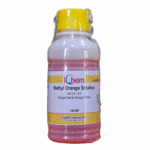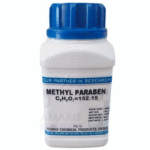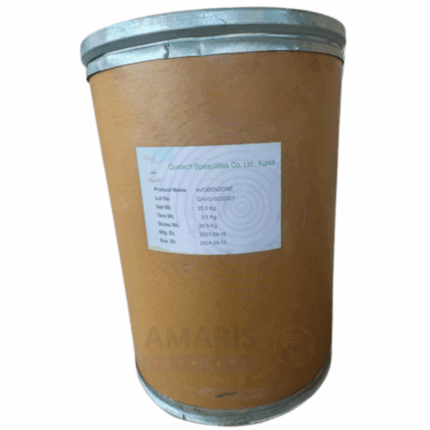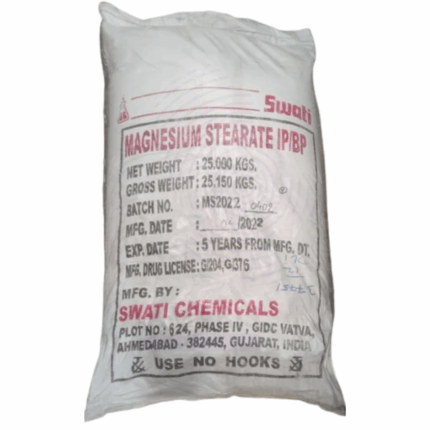
Methyl Orange Solutions Extra Pure
$ 14.85 Original price was: $ 14.85.$ 14.78Current price is: $ 14.78.

Methyl Paraben Extra Pure
$ 17.85 Original price was: $ 17.85.$ 17.78Current price is: $ 17.78.
Dextrose Monohydrate
$ 1.20 Original price was: $ 1.20.$ 1.08Current price is: $ 1.08.
Whatsapp Order
Dextrose Monohydrate is a crystalline form of glucose containing one molecule of water (monohydrate). It is a primary carbohydrate source widely used in pharmaceutical, food, and clinical nutrition applications. It provides readily available energy, serves as a sweetening agent, and acts as an osmotic agent in formulations. Dextrose Monohydrate meets pharmacopoeial standards (such as BP, USP) ensuring high purity, consistency, and safety for use in medical and food-grade products. Its solubility and stable crystalline form make it suitable for intravenous fluids, oral rehydration solutions, and food industry applications.
Description
Table of Contents
Toggle
Dextrose Monohydrate
Primary Uses
- Pharmaceutical and Clinical Nutrition
- Used as a carbohydrate source in intravenous fluids for energy provision and fluid-electrolyte balance.
- Serves as an energy substrate in total parenteral nutrition (TPN) formulations.
- Utilized in oral rehydration salts (ORS) formulations to aid hydration and energy replacement in diarrhea and dehydration cases.
- Used in pharmaceutical compounding as an excipient or stabilizer in oral syrups and solutions.
- Food and Beverage Industry
- Acts as a sweetener and texturizer in confectionery, baked goods, and beverages.
- Provides fermentable sugar for yeast in baking and brewing.
- Used as a bulking agent and humectant in processed foods.
- Laboratory and Research
- Serves as a glucose source in cell culture media and biochemical assays.
- Used in microbiological growth media for culturing bacteria and fungi.
Secondary Uses
- Cosmetics and Personal Care
- Employed as a humectant and moisturizer in skin care formulations.
- Used in oral care products for flavor and texture improvement.
- Veterinary Medicine
- Provides an energy source in veterinary parenteral and oral nutrition solutions.
- Industrial Applications
- Used in fermentation processes and as a feedstock for biotechnological products.
KEY PRODUCT FEATURES
1. Basic Identification Attributes
- Chemical Name (IUPAC): D-Glucose monohydrate
- Common/Trade Name: Dextrose Monohydrate
- CAS Number: 5996-10-1
- HS Code: 1702.90.10
- Molecular Formula: C6H12O6·H2O
- Synonyms:
- Glucose Monohydrate
- D-Glucose hydrate
- Grape Sugar (common)
- Corn Sugar (commercial)
2. Physical & Chemical Properties
- Physical State: White crystalline powder or granules
- Solubility: Highly soluble in water (~909 g/L at 20°C)
- Melting Point: Approximately 100–103°C (loses water of crystallization)
- pH (1% aqueous solution): Slightly acidic to neutral (~4.0–6.0)
- Stability: Hygroscopic; stable under recommended storage
- Molecular Weight: 198.17 g/mol (including water)
- Appearance: White, odorless, sweet-tasting crystals
3. Safety & Hazard Attributes
- Hazard Class (GHS): Not classified as hazardous
- Toxicity: Non-toxic; excessive consumption may cause hyperglycemia in diabetic patients
- Irritation: Non-irritant in typical use
- Reactivity: Stable; avoid strong oxidizing agents and acids
4. Storage & Handling Attributes
- Storage Conditions: Store in a cool, dry, well-ventilated area away from moisture
- Container Type: Sealed moisture-proof packaging (poly bags, drums)
- Shelf Life: 2–3 years when stored properly
- Handling Precautions: Avoid dust formation and moisture exposure; use PPE if handling bulk powder
5. Regulatory & Compliance Attributes
- Regulatory Status: Complies with BP, USP, EP standards for pharmaceutical and food use
- Pharmacopoeia Standards: BP, USP certified
- Transportation: Non-hazardous material
- Controlled Substance: Not controlled
6. Environmental & Health Impact
- Biodegradability: Readily biodegradable
- Ecotoxicity: Low impact
- Bioaccumulation: Not expected
- Carcinogenicity/Mutagenicity: Not carcinogenic or mutagenic
SAFETY HANDLING PRECAUTIONS
Safety Handling Precautions
- PPE Required:
- Dust mask or respirator when handling bulk powder
- Safety goggles
- Gloves (nitrile or latex)
- Protective clothing
- Handling Guidelines:
- Minimize dust generation
- Avoid moisture contamination
- Handle in well-ventilated areas
- Storage Measures:
- Keep container tightly closed
- Protect from humidity and direct sunlight
First Aid Measures
- Inhalation: Move to fresh air if dust inhaled; seek medical help if irritation persists
- Skin Contact: Wash with soap and water; usually no irritation
- Eye Contact: Rinse thoroughly with water; seek medical advice if irritation occurs
- Ingestion: Non-toxic; seek medical attention if excessive consumption causes symptoms
Firefighting Measures
- Fire Hazards: Non-flammable; dust may form explosive mixtures in air under extreme conditions
- Extinguishing Media: Use water spray, foam, dry chemical, or CO₂
- Special Precautions: Avoid dust cloud formation during firefighting
- Decomposition Products: Carbon oxides if burned
Related products
Almond Bitter Oil
Almond Bitter Oil, derived from the kernels of bitter almonds (Prunus amygdalus var. amara), is an essential oil known for its sharp, nutty, and marzipan-like aroma. This oil is produced through steam distillation of crushed bitter almond kernels and contains a naturally occurring compound called benzaldehyde, which gives it its characteristic scent. In purified form (free of hydrogen cyanide), bitter almond oil is used in fragrance, flavoring, and pharmaceutical applications.
Due to its potent aroma and biochemical properties, it is widely used in perfumery, baked goods flavoring (in controlled quantities), aromatherapy, and traditional topical remedies. It is important to distinguish between natural bitter almond oil, which must be detoxified, and synthetic benzaldehyde, which is commonly used as a substitute in commercial formulations.
Ammonia Acetate
Ammonium Acetate (NH4CH3COO) is a white crystalline solid or granular powder with a mild ammoniacal odor. It is a salt formed from ammonia and acetic acid, widely used in laboratories, industrial processes, and some niche food and pharmaceutical applications. Ammonium Acetate is highly soluble in water and often utilized as a buffer solution in biochemical and analytical chemistry due to its ability to maintain pH. It also serves as a precursor in the synthesis of various chemicals and acts as a neutralizing agent in several industrial applications.
Avobenzone
Avobenzone (chemical name: Butyl Methoxydibenzoylmethane) is an oil-soluble organic compound widely used as a UVA filter in sunscreen formulations. It is valued for its ability to absorb a broad spectrum of ultraviolet A (UVA) rays (320–400 nm), protecting the skin from premature aging and damage caused by sun exposure. Avobenzone is often combined with other UV filters to provide broad-spectrum sun protection. It is a pale yellow liquid or crystalline powder, soluble in oils and alcohols but unstable in sunlight unless stabilized with other agents.
Bitter Masking Pharmaceutical Liquid flavors
Bitter Masking Pharmaceutical Liquid Flavors are specially formulated liquid flavors designed to mask the bitter taste of active pharmaceutical ingredients (APIs). These flavors improve the palatability of oral syrups, suspensions, and liquid medications, enhancing patient compliance. Compatible with various pharmaceutical formulations, they exhibit excellent solubility and stability in aqueous systems and provide a pleasant taste profile without affecting the efficacy of the medication.
Cellulose Acetate Phthalate (CAP)
Cellulose Acetate Phthalate (CAP) is a cellulose derivative obtained by esterification of cellulose with acetic acid and phthalic anhydride. It appears as a white to off-white, free-flowing powder that is insoluble in water but soluble in alkaline solutions and certain organic solvents. CAP is primarily used as an enteric coating agent in pharmaceutical formulations, providing resistance to acidic gastric fluids and enabling targeted release of drugs in the intestines. Due to its film-forming, pH-sensitive solubility, and protective properties, CAP is also applied in food, cosmetics, and specialty industrial uses.
Magnesium Stearate BP
Magnesium Stearate BP is a fine, white, hydrophobic powder composed of the magnesium salt of stearic acid. It is widely used in the pharmaceutical industry as a lubricant and anti-adherent in tablet and capsule manufacturing. Due to its excellent flow-enhancing properties, Magnesium Stearate BP improves powder flowability and prevents ingredients from sticking to equipment during processing. It is also used in cosmetics, food, and various industrial applications for its emulsifying and stabilizing properties.
Sodium Nitrite
Sodium Nitrite is an inorganic white to slightly yellowish crystalline powder with the chemical formula NaNO₂. This versatile chemical serves as a powerful reducing agent, corrosion inhibitor, and food preservative, widely used in meat curing, pharmaceutical synthesis, and industrial applications. Its oxidative properties make it valuable for dye manufacturing and rubber processing while requiring careful handling due to its toxicity.
Sodium Starch Glycolate
Sodium Starch Glycolate (SSG) is a white to off-white, odorless, tasteless powder derived from potato or maize starch and chemically modified with carboxymethylation and cross-linking. It has the chemical formula (C₆H₁₀O₅)nNa and is widely used in solid dosage pharmaceutical formulations as a superdisintegrant. This 25kg grade is supplied in high-purity pharmaceutical and food-grade quality, offering excellent swelling capacity and rapid disintegration properties even at low concentrations.


 Preservatives(food)
Preservatives(food) Flavor Enhancers
Flavor Enhancers Acidulants
Acidulants Sweeteners
Sweeteners Antioxidants
Antioxidants Colorants(food)
Colorants(food) Nutraceutical Ingredients (food)
Nutraceutical Ingredients (food) Nutrient Supplements
Nutrient Supplements Emulsifiers
Emulsifiers
 Collectors
Collectors Dust Suppressants
Dust Suppressants Explosives and Blasting Agents
Explosives and Blasting Agents Flocculants and Coagulants
Flocculants and Coagulants Frothers
Frothers Leaching Agents
Leaching Agents pH Modifiers
pH Modifiers Precious Metal Extraction Agents
Precious Metal Extraction Agents
 Antioxidants(plastic)
Antioxidants(plastic) Colorants (Pigments, Dyes)
Colorants (Pigments, Dyes) Fillers and Reinforcements
Fillers and Reinforcements Flame Retardants
Flame Retardants Monomers
Monomers Plasticizers
Plasticizers Polymerization Initiators
Polymerization Initiators Stabilizers (UV, Heat)
Stabilizers (UV, Heat)
 Antifoaming Agents
Antifoaming Agents Chelating Agents
Chelating Agents Coagulants and Flocculants
Coagulants and Flocculants Corrosion Inhibitors
Corrosion Inhibitors Disinfectants and Biocides
Disinfectants and Biocides Oxidizing Agents
Oxidizing Agents pH Adjusters
pH Adjusters Scale Inhibitors( water)
Scale Inhibitors( water)
 Antioxidants(cosmetic)
Antioxidants(cosmetic) Emollients
Emollients Fragrances and Essential Oils
Fragrances and Essential Oils Humectants
Humectants Preservatives
Preservatives Surfactants(cosmetic)
Surfactants(cosmetic) Thickeners
Thickeners UV Filters
UV Filters
 Fertilizers
Fertilizers Soil Conditioners
Soil Conditioners Plant Growth Regulators
Plant Growth Regulators Animal Feed Additives
Animal Feed Additives Biostimulants
Biostimulants Pesticides (Herbicides, Insecticides, Fungicides)
Pesticides (Herbicides, Insecticides, Fungicides)
 Active Pharmaceutical Ingredients (APIs)
Active Pharmaceutical Ingredients (APIs) Excipients
Excipients Solvents(pharmaceutical)
Solvents(pharmaceutical) Antibiotics
Antibiotics Antiseptics and Disinfectants
Antiseptics and Disinfectants Vaccine Adjuvants
Vaccine Adjuvants Nutraceutical Ingredients (pharmaceutical)
Nutraceutical Ingredients (pharmaceutical) Analgesics & Antipyretics
Analgesics & Antipyretics
 Analytical Reagents
Analytical Reagents Solvents(lab)
Solvents(lab) Chromatography Chemicals
Chromatography Chemicals Spectroscopy Reagents
Spectroscopy Reagents microbiology-and-cell-culture-reagents
microbiology-and-cell-culture-reagents Molecular Biology Reagents
Molecular Biology Reagents Biochemical Reagents
Biochemical Reagents Inorganic and Organic Standards
Inorganic and Organic Standards Laboratory Safety Chemicals
Laboratory Safety Chemicals Specialty Laboratory Chemicals(Special Laboratory Equipment)
Specialty Laboratory Chemicals(Special Laboratory Equipment)
 Demulsifiers
Demulsifiers Hydraulic Fracturing Fluids
Hydraulic Fracturing Fluids Scale Inhibitors(oil)
Scale Inhibitors(oil) Surfactants(oil)
Surfactants(oil) Drilling Fluids
Drilling Fluids
 Dyes and Pigments
Dyes and Pigments Bleaching Agents
Bleaching Agents Softening Agents
Softening Agents Finishing Agents
Finishing Agents Antistatic Agents
Antistatic Agents
 Admixtures
Admixtures Waterproofing Agents
Waterproofing Agents Sealants and Adhesives
Sealants and Adhesives Curing Compounds
Curing Compounds Concrete Repair Chemicals
Concrete Repair Chemicals Anti-Corrosion Coatings
Anti-Corrosion Coatings
 Surfactants(cleaning)
Surfactants(cleaning) Builders
Builders Enzymes
Enzymes Solvents (Cleaning)
Solvents (Cleaning) Fragrances
Fragrances
 Electronic Chemicals
Electronic Chemicals Catalysts
Catalysts Lubricants
Lubricants Photographic Chemicals
Photographic Chemicals Refrigerants
Refrigerants Automotive chemicals
Automotive chemicals Pyrotechnic Chemicals
Pyrotechnic Chemicals
 Biodegradable Surfactants
Biodegradable Surfactants Bio-based Solvents
Bio-based Solvents Renewable Polymers
Renewable Polymers Carbon Capture Chemicals
Carbon Capture Chemicals Wastewater Treatment Chemicals
Wastewater Treatment Chemicals
 Pigments
Pigments Solvents(paint)
Solvents(paint) Specialty Coatings
Specialty Coatings Binders/Resins
Binders/Resins Additives
Additives Driers
Driers Anti-Corrosion Agents
Anti-Corrosion Agents Functional Coatings
Functional Coatings Application-Specific Coatings
Application-Specific Coatings
 Fresh Herbs
Fresh Herbs Ground Spices
Ground Spices Whole Spices
Whole Spices Spice Blends
Spice Blends Dried Herbs
Dried Herbs
 Leavening Agents
Leavening Agents Dough Conditioners
Dough Conditioners Flour Treatments
Flour Treatments Fat Replacers
Fat Replacers Decoratives
Decoratives Preservatives(baking)
Preservatives(baking)
 Plasticizers & Softeners
Plasticizers & Softeners Reinforcing Agents
Reinforcing Agents Adhesion Promoters
Adhesion Promoters Vulcanizing Agents
Vulcanizing Agents Antidegradants
Antidegradants Blowing Agents
Blowing Agents Fillers & Extenders
Fillers & Extenders Accelerators & Retarders
Accelerators & Retarders






















